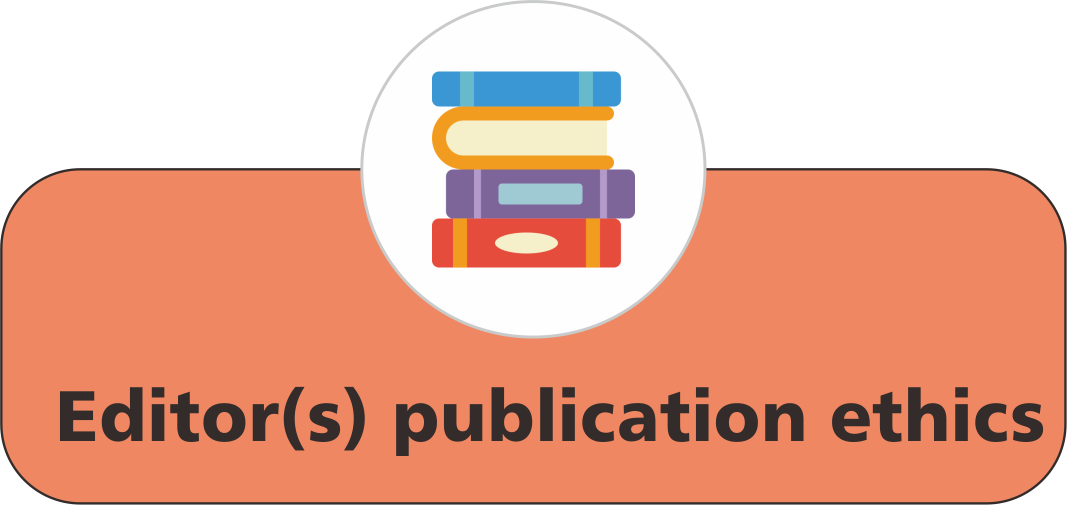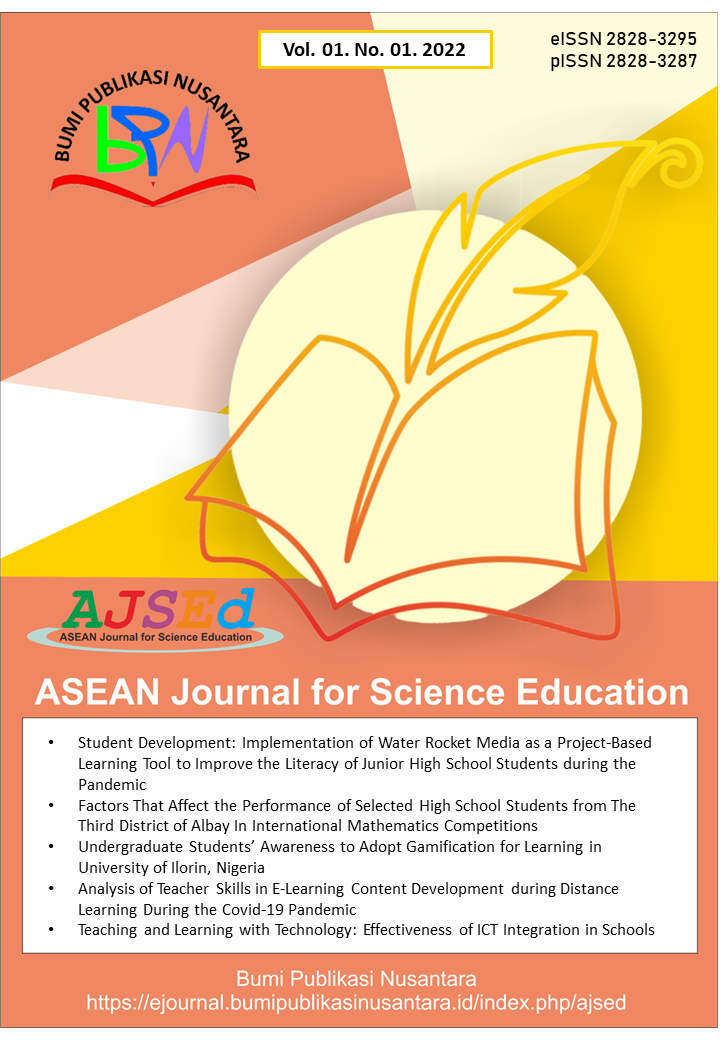Adaptive Strategies for Technical and Vocational Education and Training (TVET) Science Educators: Navigating Online Home-Based Learning
 ), Gary Renfron Anak Luta(2), Danakorn Nincarean(3),
), Gary Renfron Anak Luta(2), Danakorn Nincarean(3),
(1) Universiti Tun Hussein Onn Malaysia
(2) Universiti Tun Hussein Onn Malaysia
(3) Universiti Malaysia Al-Sultan Abdullah
 Corresponding Author
Corresponding Author
Abstract
Keywords
References
Akther, W. (2022). SDG 4: A review of challenges-Bangladesh perspective. International Journal of Multidisciplinary Informative Research and Review, 2(1), 11-19.
Amhag, L., Hellström, L., and Stigmar, M. (2019). Teacher educators' use of digital tools and needs for digital competence in higher education. Journal of Digital Learning in Teacher Education, 35(4), 203-220.
Anamalai, T. R., and Yatim, M. H. M. (2021). A preliminary observation of teacher challenges in implementing home-based teaching and learning. Journal of ICT in Education, 8(4), 55-63.
Antoninis, M., April, D., Barakat, B., Bella, N., D’Addio, A. C., Eck, M.,and Zekrya, L. (2020). All means all: An introduction to the 2020 global education monitoring report on inclusion. Prospects, 49, 103-109.
Ashima, R., Haleem, A., Bahl, S., Javaid, M., Mahla, S. K., and Singh, S. (2021). Automation and manufacturing of smart materials in additive manufacturing technologies using Internet of things towards the adoption of Industry 4.0. Materials Today: Proceedings, 45, 5081-5088.
Azhar, E. I., and Hashim, H. F. M. (2022). 2D public service announcement: Challenge home-based learning during Pandemic on University Students. Journal of Computing Technologies and Creative Content (JTEC), 7(2), 71-77.
Dabi, G. K. (2022). Implementation of integrated functional adult literacy curriculum in South Eastern Ethiopia: Preconditions and challenges. Journal of Equity in Sciences and Sustainable Development (JESSD), 5(1), 58-75.
Davis, F. D. (1989). Perceived usefulness, perceived ease of use, and user acceptance of information technology. MIS Quarterly, 13(3), 319-340.
Drajati, N. A., Tan, L., Haryati, S., Rochsantiningsih, D., and Zainnuri, H. (2018). Investigating English language teachers in developing TPACK and multimodal literacy. Indonesian Journal of Applied Linguistics, 7(3), 575-582.
Esfijani, A., and Zamani, B. E. (2020). Factors influencing teachers' utilization of ICT: The role of in-service training courses and access. Research in Learning Technology, 28, 2313.
Fadel, N. S. M., Ishar, M. I. M., Jabor, M. K., Ahyan, N. A. M., and Janius, N. (2022). Application of soft skills among prospective TVET teachers to face the industrial revolution 4.0. Malaysian Journal of Social Sciences and Humanities (MJSSH), 7(6), e001562-e001562.
Ghavifekr, S., and Yulin, S. (2021). Role of ICT in TVET education: Teaching and learning amid COVID-19 pandemic. International Journal of Advanced Research in Education and Society, 3(1), 119-131.
Ghavifekr, S., Kunjappan, T., Ramasamy, L., and Anthony, A. (2016). Teaching and learning with ICT tools: Issues and challenges from teachers' perceptions. Malaysian Online Journal of Educational Technology, 4(2), 38-57.
Guillén-Gámez, F. D., Mayorga-Fernández, M., Bravo-Agapito, J., and Escribano-Ortiz, D. (2021). Analysis of teachers’ pedagogical digital competence: Identification of factors predicting their acquisition. Technology, Knowledge and Learning, 26(3), 481-498.
Günther‐Bel, C., Vilaregut, A., Carratala, E., Torras‐Garat, S., and Pérez‐Testor, C. (2020). A mixed‐method study of individual, couple, and parental functioning during the state‐regulated COVID‐19 lockdown in Spain. Family Process, 59(3), 1060-1079.
Hassan, R. H., Hassan, M. T., Naseer, S., Khan, Z., and Jeon, M. (2021). ICT enabled TVET education: A systematic literature review. IEEE Access, 9, 81624-81650.
Hou, Z., and Aryadoust, V. (2021). A review of the methodological quality of quantitative mobile-assisted language learning research. System, 100, 102568.
Hu, X., Gong, Y., Lai, C., and Leung, F. K. (2018). The relationship between ICT and student literacy in mathematics, reading, and science across 44 countries: A multilevel analysis. Computers and Education, 125, 1-13.
Hu, Y., Ow Yong, J. Q. Y., Chng, M. L. C., Li, Z., and Goh, Y. S. (2022). Exploring undergraduate nursing students’ experiences towards home-based learning as pedagogy during the COVID-19 pandemic: A descriptive qualitative exploration. BMC Nursing, 21(1), 1-9.
Husni, H., Munandar, A. A., Darisman, D., and Rizal, S. S. (2020). Preferable applications for home-based learning during the coronavirus (COVID-19) outbreak in Indonesia Islamic Higher Education. International Journal of Scientific and Technology Research, 9, 281-284.
Ian O’Byrne, W., Savitz, R. S., Morrison, J., Kane, B., Lilly, T., Ming, K. M., and Aldrich, C. (2021). Literacy across the disciplines: Development and validation of an instrument to assess literacy instruction in middle and high school classrooms. The Clearing House: A Journal of Educational Strategies, Issues and Ideas, 94(2), 63-75.
Ja'ashan, M. M. N. H. (2020). The challenges and prospects of using e-learning among EFL students in Bisha University. Arab World English Journal (AWEJ), 11, 1-14.
Janse, R. J., Hoekstra, T., Jager, K. J., Zoccali, C., Tripepi, G., Dekker, F. W., and van Diepen, M. (2021). Conducting correlation analysis: Important limitations and pitfalls. Clinical Kidney Journal, 14(11), 2332-2337.
Joo, Y. J., Park, S., and Lim, E. (2018). Factors influencing preservice teachers’ intention to use technology: TPACK, teacher self-efficacy, and technology acceptance model. Journal of Educational Technology and Society, 21(3), 48-59.
Kundu, A., and Bej, T. (2021). COVID 19 response: An analysis of teachers’ perception on pedagogical successes and challenges of digital teaching practice during new normal. Education and Information Technologies, 26(6), 1-24.
L Ritter, N. (2017). Technology acceptance model of online learning management systems in higher education: A meta-analytic structural equation model. International Journal of Learning Management Systems, 5(1), 1-16.
Lawrence, J. E., and Tar, U. A. (2018). Factors that influence teachers' adoption and integration of ICT in the teaching/learning process. Educational Media International, 55(1), 79-105.
Liu, S. (2021). Family engagement in the home-based learning mode: An enlarging divide in education. Social Transformations in Chinese Societies, 17(2), 92-100.
Lubis, A. H., Syed Idrus, S. Z., and Sarji, A. (2018). ICT usage amongst lecturers and its impact on learning process quality. Jurnal Komunikasi Malaysian Journal of Communication, 34(1), 284-299.
Mansor, A. N., Zabarani, N. H., Jamaludin, K. A., Mohd Nor, M. Y., Alias, B. S., and Mansor, A. Z. (2021). Home-based learning (HBL) teacher readiness scale: Instrument development and demographic analysis. Sustainability, 13(4), 2228.
Mazlan, A. F., Mohamad, M., Reesha, A., Kassim, R., Othman, Z., and Kummin, S. (2021). Challenges and strategies to enhance online remote teaching and learning by tertiary institution educators: A literature review. Creative Education, 12(4), 718-726.
MERDİN, D., ERSÖZ, F., and TAŞKIN, H. (2022). Digital transformation: Digital maturity model for Turkish businesses. Gazi University Journal of Science, 36(1), 263-282.
Mishra, P., and Koehler, M. J. (2006). Technological pedagogical content knowledge: A framework for teacher knowledge. Teachers’ College Record, 108(6), 1017-1054.
Moorhouse, B. L. (2020). Adaptations to a face-to-face initial teacher education course ‘forced’ online due to the COVID-19 pandemic. Journal of Education for Teaching, 46(4), 609–611.
Neupane, M. S. (2020). TVET programs in Nepal: Issue of access and relevancy. Journal of Training and Development, 5, 16-28.
Pimentel, C. B., Clark, V., Baughman, A. W., Berlowitz, D. R., Davila, H., Mills, W. L., and Hartmann, C. W. (2021). Health care providers and the public reporting of nursing home quality in the United States Department of Veterans affairs: Protocol for a mixed methods pilot study. JMIR Research Protocols, 10(7), e23516.
Prasad, M. (2023). Technological intervention in educational industry-post pandemic development and growth. Carmelight, 21, 41-44.
Rampazzo, M., and Beghi, A. (2018). Designing and teaching of an effective engineering continuing education course: Modeling and simulation of HVAC systems. Computer Applications in Engineering Education, 26(4), 739-748.
Rashid, A. H. A., Shukor, N. A., Tasir, Z., and Na, K. S. (2021). Teachers' perceptions and readiness toward the implementation of virtual learning environment. International Journal of Evaluation and Research in Education, 10(1), 209-214.
Rosado, P. J., and Levinson, R. (2019). Potential benefits of cool walls on residential and commercial buildings across California and the United States: Conserving energy, saving money, and reducing the emission of greenhouse gases and air pollutants. Energy and Buildings, 199, 588-607.
Semerci, A., and Aydin, M. K. (2018). Examining high school teachers' attitudes towards ict use in education. International Journal of Progressive Education, 14(2), 93-105.
Shrestha, N. (2021). Factor analysis as a tool for survey analysis. American Journal of Applied Mathematics and Statistics, 9(1), 4-11.
Song, H., Kim, J., and Luo, W. (2016). The teacher-student relationship in online classes: A role of teacher self-disclosure. Computers in Human Behavior, 54, 436–443.
Tay, L. Y., Lee, S. S., and Ramachandran, K. (2021). Implementation of online home-based learning and students’ engagement during the COVID-19 pandemic: A case study of Singapore mathematics teachers. The Asia-Pacific Education Researcher, 30(3), 299-310.
Thannimalai, T., and Baloh, S. (2021). Challenges of Tamil language PDPR in rural schools. Muallim Journal of Social Sciences and Humanities, 5(2), 183-190.
Valtonen, T., Kukkonen, J., Kontkanen, S., Mäkitalo‐Siegl, K., and Sointu, E. (2018). Differences in pre‐service teachers' knowledge and readiness to use ICT in education. Journal of Computer Assisted Learning, 34(2), 174-182.
Walkington, C., and Bernacki, M. L. (2020). Appraising research on personalized learning: Definitions, theoretical alignment, advancements, and future directions. Journal of Research on Technology in Education, 52(3), 235-252.
Weiwei, Z. (2022). Concepts and practice used in vocational education for international development during COVID-19 in China. Higher Education and Oriental Studies, 2(3), 15-23.
Wen, Y., Gwendoline, C. L. Q., and Lau, S. Y. (2021). ICT-supported home-based learning in K-12: A systematic review of research and implementation. TechTrends, 65(3), 371-378.
Yeap, C. F., Suhaimi, N., and Nasir, M. K. M. (2021). Issues, challenges, and suggestions for empowering technical vocational education and training education during the COVID-19 pandemic in Malaysia. Creative Education, 12(8), 1818-1839.
Article Metrics
Abstract View : 963 times
: 963 times Download : 542 times
Download : 542 times
Refbacks
- There are currently no refbacks.
Copyright (c) 2023 Bumi Publikasi Nusantara

This work is licensed under a Creative Commons Attribution-ShareAlike 4.0 International License.







